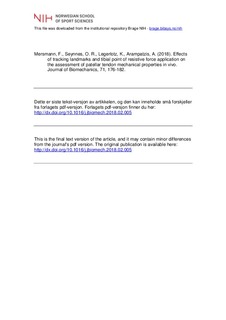Effects of tracking landmarks and tibial point of resistive force application on the assessment of patellar tendon mechanical properties in vivo
Journal article, Peer reviewed
Accepted version
Permanent lenke
http://hdl.handle.net/11250/2596958Utgivelsesdato
2018Metadata
Vis full innførselSamlinger
- Artikler / Articles [2096]
- Publikasjoner fra Cristin [1084]
Sammendrag
The different methods used to assess patellar tendon elongation in vivo may partly explain the large variation of mechanical properties reported in the literature. The present study investigated the effects of tracking landmark position and tibial point of resistive force application during leg extensions in a dynamometer. Nineteen adults performed isometric contractions with a proximal and distal dynamometer shank pad position. Knee joint moments were calculated employing an inverse dynamics approach. Tendon elongation was measured using the patellar apex and either the tibial tuberosity (T) or plateau (P) as tracking landmark. Using P for tracking introduced a bias towards greater values of tendon elongation at all force levels from 100 N to maximum tendon force (TFmax; p < 0.05). The differences between landmarks considering maximum tendon strain were greater at the proximal shank pad position (p < 0.05). Tendon stiffness was lower for P compared with T, but only in intervals up to 50% of TFmax (p < 0.05). The agreement between T and P for stiffness calculated between 50% and TFmax was acceptable with the distal, but poor with the proximal pad position. We demonstrated that using the tibia plateau and not the insertion as tracking landmark clearly affects the assessment of the force–elongation curve of the patellar tendon. However, using a distal point of resistive force application and calculating tendon stiffness between 50% and TFmax seems to yield an acceptable agreement between landmarks. These findings have important implications for the assessment of tendon properties in vivo and cross-study comparisons.
Beskrivelse
I Brage finner du siste tekst-versjon av artikkelen, og den kan inneholde ubetydelige forskjeller fra forlagets pdf-versjon. Forlagets pdf-versjon finner du på sciencedirect.com / In Brage you'll find the final text version of the article, and it may contain insignificant differences from the journal's pdf version. The definitive version is available at sciencedirect.com
